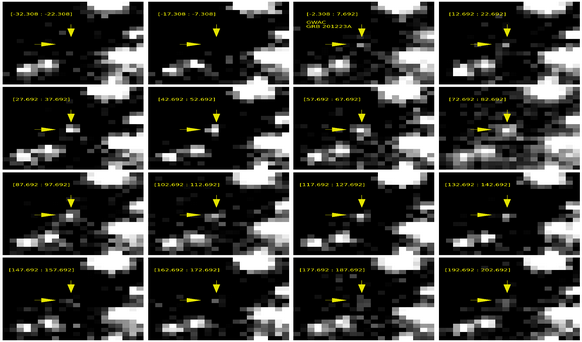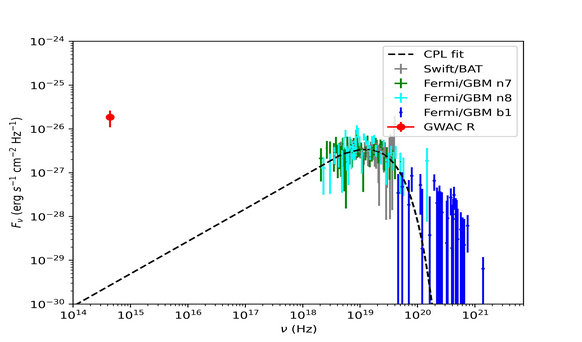GWAC detected prompt optical emission of a gamma-ray burst
Gamma-ray bursts (GRBs) are produced by the collapse of massive stars or the merger of binary neutron stars, accompanied by extreme relativistic jets emitting enormous amounts of energy within a few seconds after the bursts. This includes the prompt emission caused by the shock in the jet and the afterglow produced by the interaction between the jet and external medium. Typical high-energy emission last only a few milliseconds to tens of seconds, and it is difficult to follow up in real time when ground-based optical telescopes receive alerts triggered by spaced high-energy instruments.
Up to date, there are only a few cases of optical emission detected before the end of prompt high-energy emission in the GRBS with longer duration of high-energy bursts (>30 seconds). And all these measurements were contaminated with reverse shock making it difficult to clearly review the transition from prompt optical emission to afterglow.
On April 10, 2023, Nature Astronomy published an important research led by the Space-based Multi-band Astronomical Variable Objects Monitor (SVOM) research team of the National Astronomical Observatories of the Chinese Academy of Sciences (NAOC). The researchers detected the prompt optical emission and its transition to the early afterglow of a gamma-ray burst (GRB 201223A), using the Ground Wide Angle Camera Array (GWAC) located at Xinglong Observatory of NAOC. The first author of the research is Dr. XIN Liping, associate researcher from NAOC.
As one of the key ground-based telescopes for the SVOM project, GWAC, proposed and led by Prof. WEI Jianyan, the principal investigator of the SVOM mission, can cover an ultra large skywith a temporal resolution of 15 seconds and a detection capability of 16 magnitude. Its scientific purpose is to conduct systematic research on the prompt optical emission of gamma-ray bursts discovered by SVOM mission.
GWAC recorded the entire process, before, during and after the event, nvisual wavelength (Figure 1). The emergency of optical and gamma-rays emission was detected simultaneously. (Figure 2)

Figure 1: Successive GWAC observations of GRB 201223A before, during and after the high-energy burst. The temporal resolution is 15 seconds. The middle yellow arrow points to the optical counterpart. The image in the third column of the first row covers the trigger time. (Image by NAOC)

Figure 2: The optical, X-ray and gamma-ray light curves of GRB 201223A. The red data in the upper panel was obtained with GWAC and F60A (Image by NAOC).
The prompt optical emission of the event is far brighter than the expected if only gamma-ray emission is analyzed (Figure 3), which requires a special physical interpretation for these measurements.
It is expected that there are strong stellar winds around a massive star which is thought to be the ideal progenitor of a gamma-ray burst. However, the stellar wind is quite small for this event, even at the very close distance from the burst, which suggests a small stellar mass of the progenitor.
After the launch of SVOM, simultaneous observations by GWAC and SVOM spaced instruments are potential to provide essential data for GRB studies, and a large golden sample could be built during the life of SVOM mission.

Figure 3: Spectral energy distribution of GRB201223A. The data from GWAC in red is higher than the value extrapolated from the best model for the gamma-ray emission for about four orders of miniguide. (Image by NAOC)
The research paper is available on April 10, 2023, at https://www.nature.com/articles/s41550-023-01930-0
Media Contact:
Prof. XU Ang
Email: annxu@nao.cas.cn
Web: http://nao.cas.cn